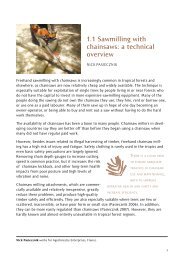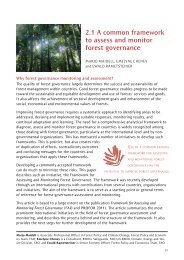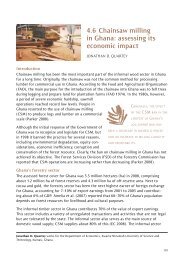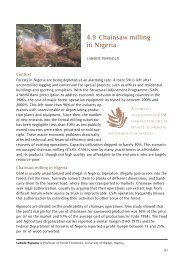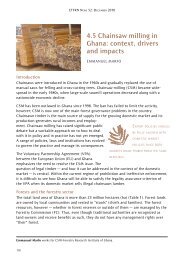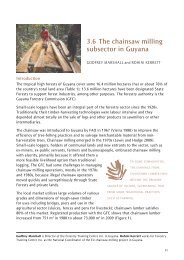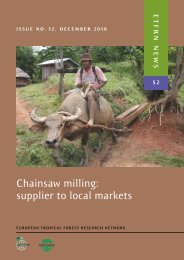Chainsaw milling: supplier to local markets - European Tropical ...
Chainsaw milling: supplier to local markets - European Tropical ...
Chainsaw milling: supplier to local markets - European Tropical ...
You also want an ePaper? Increase the reach of your titles
YUMPU automatically turns print PDFs into web optimized ePapers that Google loves.
148<br />
ETFRN NEws 52: DEcEmbER 2010<br />
incentives (granting micro-credit and securing legal rights) needs <strong>to</strong> be put in place by<br />
the public authorities. it is unclear how <strong>to</strong> address these issues — and the problems of<br />
the participa<strong>to</strong>ry zoning process and the creation of community forests — with the active<br />
involvement of civil society.<br />
so far, the authorities have been interested in taxation of the industry instead of<br />
addressing a broad perspective of land-use planning and the rights of indigenous and <strong>local</strong><br />
communities. The transition from informal <strong>to</strong> formal also means a change of approach<br />
in fighting illegal practices and networks, which are established and well consolidated.<br />
Development and research partners (iuCn, CiFor, ForaF and wCs) need <strong>to</strong> support<br />
governments in this struggle.<br />
conclusions<br />
it is clear that Csm brings wealth <strong>to</strong> <strong>local</strong> chainsaw bosses, but not <strong>to</strong> a majority of the<br />
population or the state economy. solutions are urgently needed.<br />
if the formalization of Csm is the ultimate step <strong>to</strong> reconciling poverty reduction and<br />
environmental protection, it involves intermediate steps that require the strengthening<br />
of state control, the harmonizing of transboundary trade regulations and the mobilization<br />
of funds. The combination of domestic and external pressure is an important link in<br />
promoting legality. The establishment of a national regula<strong>to</strong>ry framework, discussed and<br />
validated by all stakeholders, will provide opportunities for organizational improvements<br />
in the sec<strong>to</strong>r.<br />
Endnotes<br />
1. See PFBC (Partenariat pour les Forêts du Bassin du Congo). 2006. Les Forêts du Bassin du Congo, Etat<br />
des forêts.<br />
2. See Vundu dia Massamba, Présentation sur la règlementation de l’exploitation artisanale des bois en<br />
RDC, in Rapport de la journée de concertation sur la règlementation de l’exploitation artisanale des bois en<br />
République Démocratique du Congo, IUCN, Kinshasa, February 29, 2010.<br />
3. In the Mombasa area, cash payments are higher, ranging between US$100 for 10 ha and US$600<br />
for 50 ha.<br />
4. See de Wasseige et al. 2006; presentations at the International Conference on the management of<br />
the DRC forests (Brussels, 2007); Studies on the REDD+ potential of the DRC by the Ministry of<br />
Environment, Nature Conservation and Tourism, and studies by IKV Pax Christi (2007) and Adebu<br />
and Abdala (2010).<br />
5. This is from the communication of the Association Congolaise des Exploitants Forestiers Artisanaux<br />
(ACEF) <strong>to</strong> its members.<br />
6. The regulations for community forestry are still being developed.<br />
7. In DRC, timber is exported <strong>to</strong> Angola via Uganda and Kenya; <strong>to</strong> Uganda via Kasindi; <strong>to</strong> Sudan via<br />
Aru; and <strong>to</strong> Rwanda and Burundi via Butembo-Goma.



